In August 2012 I walked a convoluted route from the West 233rd Street station on the #2 elevated northwest, east and northwest again through Woodlawn Heights (or is it Woodlawn? I call the cemetery Woodlawn) southern Yonkers and northern Riverdale, one of the pleasanter walks in town–to a point, which I will explain later. The area figured prominently in the War for Independence, and probably has more immigrant Irish than any other of the city’s Irish enclaves such as Woodside, Queens and Bay Ridge, Brooklyn.
GOOGLE MAP: WOODLAWN HEIGHTS TO RIVERDALE
As far as the Revolutionary connection goes…
On August 31, 1778, 17 Mohican Indians, led by Chief Abraham Nimham and fighting on the side of the patriots, were massacred after their defeat by Colonel John Graves Simcoe and his Queens Rangers, fighting for the Crown. The Indians are commemorated at Indian Field in Van Cortlandt Park on East 233rd Street east of Jerome Avenue. The Mohicans, all from Stockbridge, Massachusetts, had tracked the British through the Bronx but were finally met by an overwhelming force of British and Hessian troops. This battle, on land owned by the Devoe family, was the only one in the Revolutionary War that occurred completely within what would become Van Cortlandt Park. Chief Nimham was commemorated by tiny Nindham Place in Kingsbridge Heights, but that street has since been demapped. The Chief Nimham Memorial, meanwhile, a plaque and a cairn erected by the DAR in 1906, is located on Van Cortlandt Park East at Oneida Avenue.
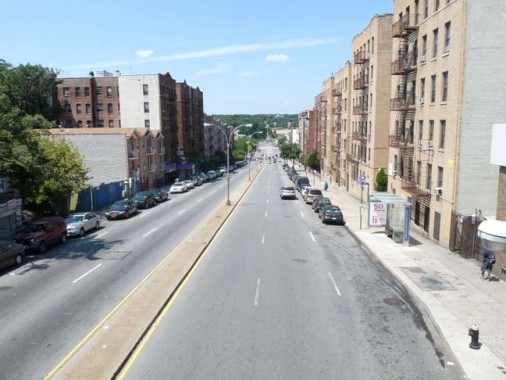
East 233rd Street, one of the busiest east-west streets in northern Bronx, runs from Jerome Avenue near Indian Field east to Boston (Post) Road at the Hutchinson River. It had been called Eastchester Street and 19th Avenue before this part of the Bronx adopted Manhattan street numbering in 1894.
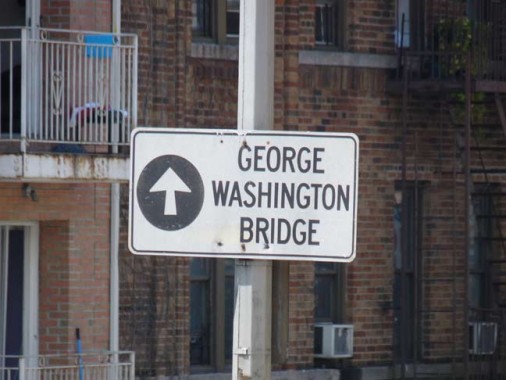
You can identify older highway signs in NYC if they aren’t green. To reach the GWB from here you would enter the Major Deegan Expressway at Jerome Avenue, south to the Alexander Hamilton Bridge, and then west on the Trans-Manhattan Expressway.

Montefiore Medical Center, East 233rd Street and Bronx Boulevard. One of the Bronx’ premier hospitals, Montefiore is the treatment center for the Albert Einstein School of Medicine. It is headquartered further south in Norwood, and in 2008 acquired this location, formerly Our Lady of Mercy Medical Center. Its namesake, Sir Moses Montefiore (1784-1885) , was a financier, banker and philanthropist who made frequent massive donations to aid the Jewish community in Palestine, and all over the world. His father’s family was originally from Leghorn, Italy, hence his Italian surname. He is also remembered in NYC by Montefiore Cemetery in St. Albans, Queens and the massive Montefiore Apartments in Norwood, Bronx.

THE WOODLAWN CEMETERY.
Crossing the Bronx River and its Parkway, you are on the southern edge of Woodlawn Heights and are in view, on your left, of Woodlawn Cemetery, which, along with Brooklyn’s Green-Wood Cemetery is the premier garden cemetery in NYC. It was incorporated in 1863 by theologian Rev. Absolom Peters (a short street named Peters Place is off East 233rd) with its first interment in 1865.
A few years ago I shot several scenes in The Woodlawn Cemetery but have yet to use them! I should get cracking. The cemetery is the final home of department store founders James Cash Penney and Roland Hussey Macy, jazzmen Duke Ellington and Miles Davis, and Mayor Fiorello LaGuardia, and many other luminaries.
Fittingly, as we’ll see, Woodlawn is also a village in County Galway, Ireland.
Woodlawn, or Woodlawn Heights, is a parallelogram of territory defined by the Bronx River, Van Cortlandt Park, Woodlawn Cemetery, and the Bronx-Westchester County Line, which forms the northern boundary of VCP but runs across several cross streets here. The neighborhood boasts several colorful street names, such as Kepler, named for the German astronomer Johannes Kepler (1571-1630); and Vireo, the small woodland bird (many Woodlawn streets once carried birds’ names such as Quail and Sparrow).
The main shopping street, Katonah Avenue, is from a Native American term meaning “great mountain.” Woodlawn Heights and southern Yonkers are located in a hilly region. Apparently, the avenue and the mid-Westchester County town were named independently.
According to the NY Times in 2011, 44% of Woodlawn’s population was of Irish extraction. A look at the businesses along Katonah Avenue will bear this out, with even the deli awning signs bearing an Irish symbol such as a harp or a shamrock. Woodlawn has been Irish since the 1840s, when Irish immigrants fleeing the potato famine joined gangs building the Croton Aqueduct from several miles north down to the former reservoir where Bryant Park sits now. Woodlawn’s Irish population is always prominent, but ebbs and flows in association with Ireland’s economic situation: when it was flying high in the 1990s, it decreased here but when it guttered in the 2000s, more Irish arrived.
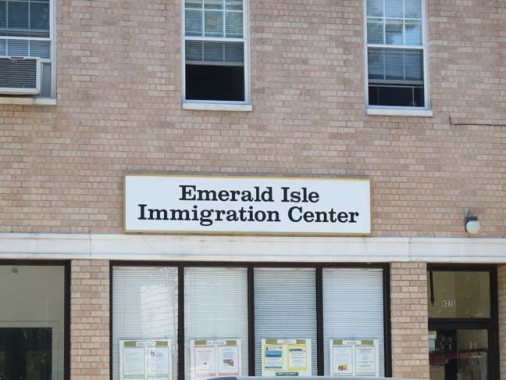
In Woodlawn, the Emerald Isle Immigration Center, and in Yonkers, the Aisling Irish Community Center, see to the needs of recent Irish immigrants. Surprisingly, most Irish expats now travel to Canada, New Zealand or Australia, since their immigration laws are not as arduous as the USA’s.
Pubs, almost all of which display the Irish tricolor in addition to the Stars and Stripes, come thick and fast along Katonah Avenue. The most well-known of them is likely the Rambling House, which has played host to Irish-American City Council president Christine Quinn, as well as Mayor Bloomberg, when they visit the area.
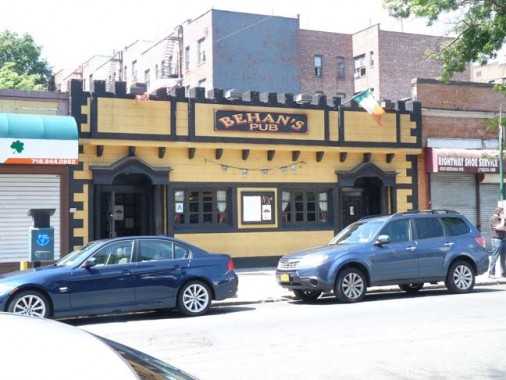
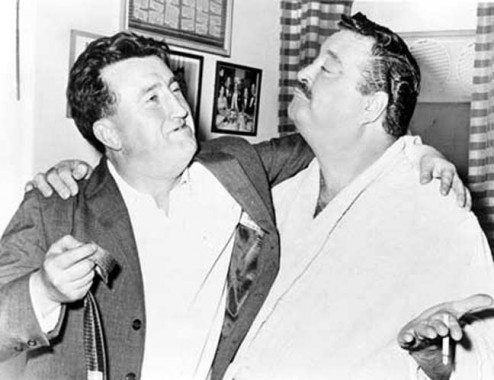
Brendan Behan (1923-1964; shown here with Jackie Gleason) was a poet, writer, novelist, playwright, and Irish Republican Army supporter. He spent time in Hollesley Bay Borstal, Suffolk, England (a youth detention center), inspiring his 1958 autobiography, Borstal Boy. He was fluent in Irish and composed several plays in that language. Unfortunately his alcoholism claimed his life at the young age of 41.
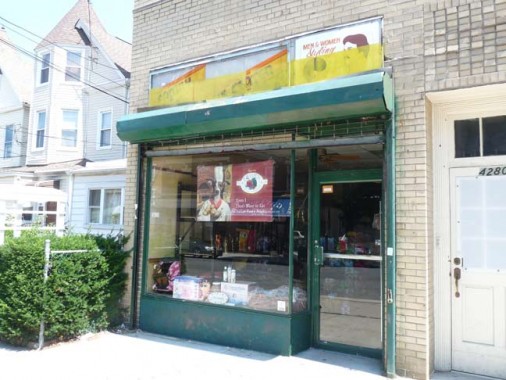
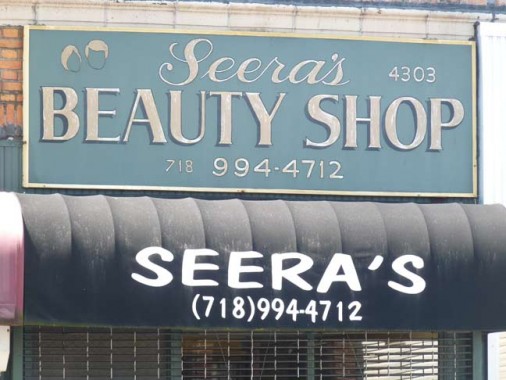
Store signs along Katonah Avenue are interesting. Some appear to be hand-drawn with paint, a T-square and a triangle. Here a pair of beauty shops display vintage looks.

Another hand-drawn sign for Danton Plumbing.
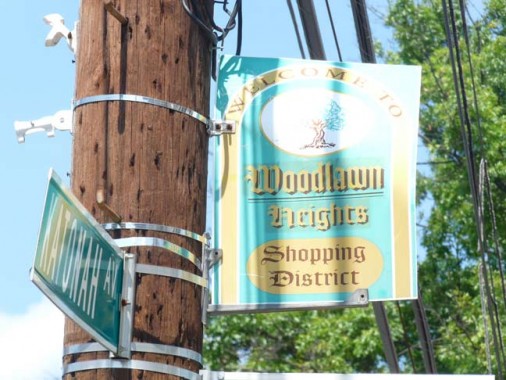
These signs installed along Katonah Avenue seem to set the issue straight, Woodlawn or Woodlawn Heights. The sign uses one of my favorite fonts, generally used in Bibles or prayerbooks, Goudy Text, first drawn by the type world’s pre-eminent designer, Frederic Goudy (1865-1947).
“In 1928, Frederic W. Goudy completed Goudy Text for Lanston Monotype. It is a modification of the blackletter types of Gutenberg’s 42-line Bible. With Lombardic capitals that work beautifully with its lowercase letters, Goudy Text is readable to those who are not used to looking at blackletters, and as such can be used to great advantage in short headings and display work.”
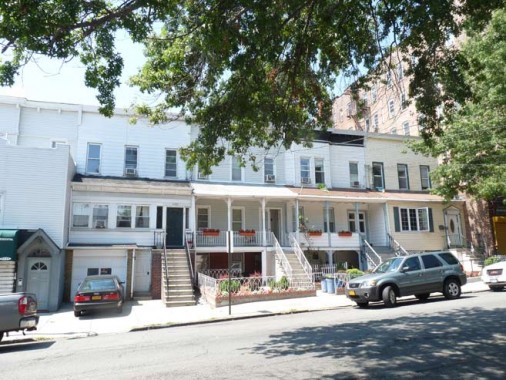
A group of older porched homes along Katonah Avenue.
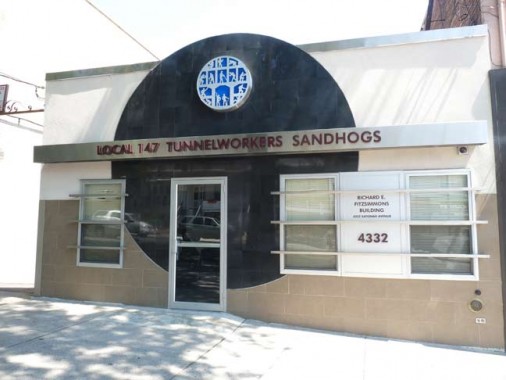
Usually, union headquarters are nondescript affairs, but this is actually a quite handsome one at 4332 Katonah for Local 147 Tunnelworkers. The union has many Irish immigrant workers who are building NYC Water Tunnel #3. Construction began in 1970 and will be finished around 2020.

More Irish businesses, more handmade signs. Mary’s Celtic Kitchen features comfort food like shepherd’s pie, fish and chips, onion rings and burgers. I’m told that shepherd’s pie in the States uses ground beef but lamb in Ireland — hence, the ‘shepherd’ in the name.

Prime Cuts, a butcher shop, uses illuminated lettering reminiscent of that used in medieval items such as the Book of Kells, which is displayed at Trinity College in Dublin.
And now, something of a mystery. The wonderfully weathered stone church at Katonah and East 241st at present is the Trinity Community Church, but it likely has gone under other guises and names. Unfortunately the church has no immediately obvious cornerstone, and the internet is silent about its origin, and the AIA Guide to NYC does not mention it. If any local has some information, pass it along!

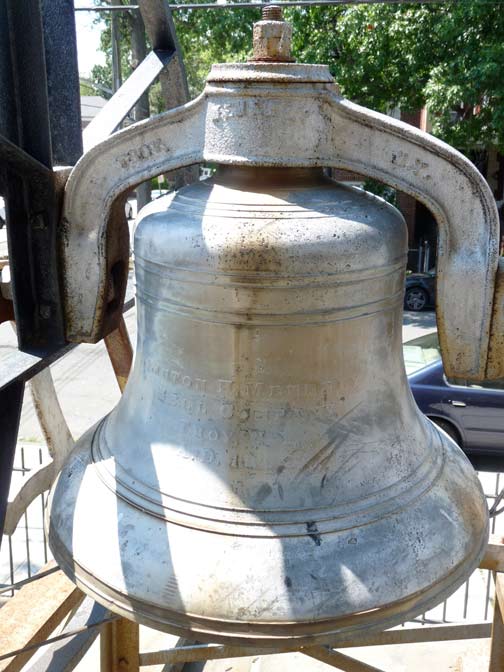
What could be the church’s original bell is displayed inside the front gate. It is inscribed: Clinton H. Meneely Bell Company, Troy, N.Y. A.D. 1892.
ForgottenFan Joe Brennan, in Comments: The Arcadia book “Northwest Bronx” identifies the church at Katonah and 241st as originally the Methodist Episcopal Church of Woodlawn Heights. The book has a photo of the congregation’s previous building and says they moved to a new one at that location in 1913. Later called St Luke’s United Methodist Church.
There’s an unusual space at Katonah Avenue and East 242nd just before the Bronx-Westchester line where the Bx 31, Bx 34 and Bx Manhattan Express #4 buses turn around. Like vampires who cannot cross running water, MTA bus lines don’t enter Westchester County (though the Bee Line in Westchester enters the undefended border with no trouble.)
Here we also find an unusual memorial installed by the Department of Environmental Protection in honor of the tunnelworkers and sandhogs (see above) who lost their lives in the construction of Tunnel #3. There is also a callout to Monsignor Considine of St. Barnabas Church (see below).


At the county line, the confluence of Van Cortlandt Park East and Katonah Avenue becomes Kimball Avenue, a major north-south Yonkers route. The first address on Kimball Avenue is St. Mark’s Lutheran Church.
Note the Westinghouse Silverliner OV-25 luminaire on the telephone pole. While the Department of Transportation in NYC has been ruthless in converting nearly all its lamps into the new GE M400, Westchester is more merciful and has left several examples of this very early 1960s light. (I don’t know it they are fitted with mercury or sodium bulbs.)
Yonkers
Yonkers, just over the northwest Bronx line, is the 4th most populous city in NY State, after New York City, Buffalo and Rochester; yes, it is larger than Albany and Syracuse. It’s a very historic town and I mean to explore it more thoroughly some day. To date, all of my Yonkers forays, like the one you’re reading, have been concentrated near the Bronx line.
What is now Yonkers was part of a land grant in the Dutch colonial era purchased in July 1645 by Adriaen van der Donck, a scholar, author and local political leader. He was known by a Dutch term of respect, “Jonkheer,” or “young gentleman.” After the British took over beginning in 1664, they bowdlerized it into the English spelling and pronunciation-friendly “Yonkers.” Over the decades, Yonkers was the place where Elisha Otis built his elevators and Bakelite plasticware was produced. Yonkers was one of NYS’s premier manufacturing towns until the years following WWII.
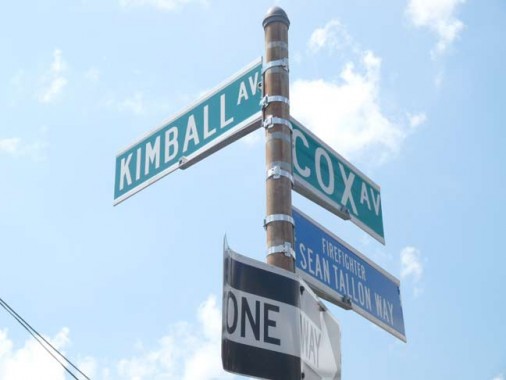
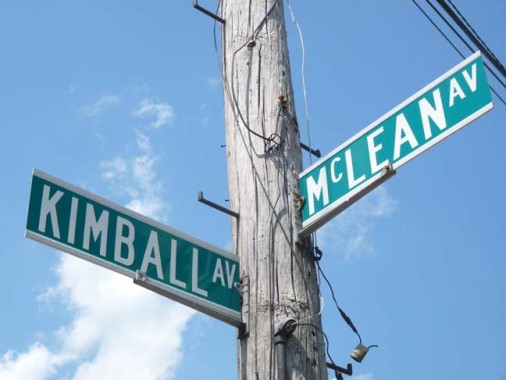
In recent years, Yonkers has modified it street signage to look almost exactly like the green and white signs with the Highway Gothic font used by NYC (and even newer signs use the upper and lower case Cleartype font, matching NYC’s new signs). There are differences, though, that can be spotted by the trained eye. The white stripes at the top and bottom of the sign are several millimeters wider than the ones found on NYC signs, and the brackets holding them to poles are different.
The all caps Highway Gothic is still the handsomest new street sign, with an authority Cleartype can’t match, in my opinion.
Ned Devine’s, on McLean east of Kimball, has a couple of painted scenes presumably showing life in Ireland. The guy in front, with the pint of Guinness, looks like Norm Crosby.
McLean Avenue is also lined with Irish-associated businesses, especially between the Bronx River and Kimball Avenue. McLean Avenue is the southernmost major east-west street in Yonkers, running from Broadway east to the Bronx River Parkway. As it runs over quite hilly territory, it makes several twists and turns along the way.
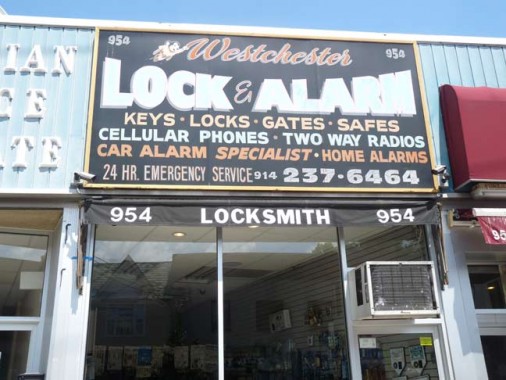
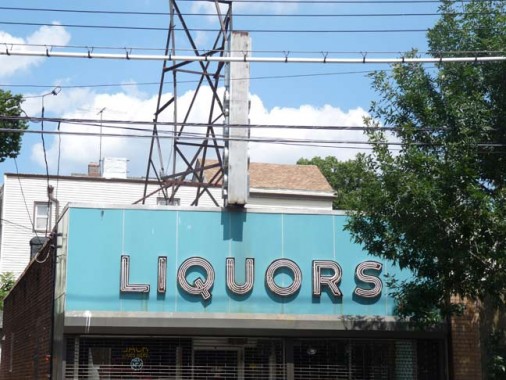
A hand-lettered locksmith awning sign and a vintage neon liquor store sign, likely from the 1950s. In NYC there has always been a great many decades-old liquor store signs with classic neon. They get the job done, so there’s no need to replace them.
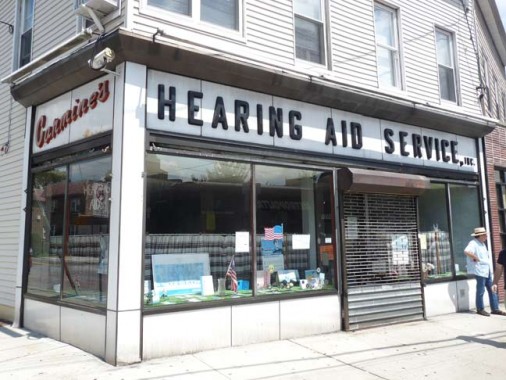
Carmine’s Hearing Aid Service, McLean and Woodlawn Avenues. This ad is probably not younger than 1955, and like the liquor store sign, it’s still getting the job done.
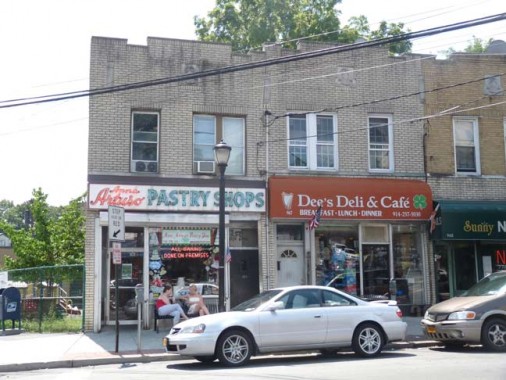
Despite the overwhelming Irishness, there is also a trace of Italian along McLean Avenue with a few pizzerias plus this pasticceria in the Italian flag colors of white, red and green on its neon sign. I don’t know why the sign says ‘shops’ when there’s one shop.

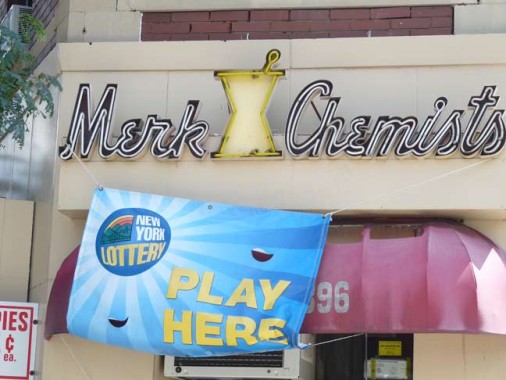
Another neon sign, Merk Chemists, McLean and Martha Avenues.
There was some byplay between me and the three guys sitting in front of the drugstore:
–Hey, take my picture! (in a dismissive tone)
–Me: I don’t think so.
–Guy has some attitude.
–I’ll take that camera and shove it down his throat.
Another time I was in Yonkers, a guy at a gas station asked me what I was doing when he caught me shooting photos of some Westy Silverliners along Bronx River Road. I mollified him by giving him my Forgotten NY card.
I suspect there would be no mollifying these guys and I didn’t answer back. You never know, they might be Mob. Or cops.
I would, though, like to get to the bottom of why photography is considered so aberrant by so many, from cops on down.
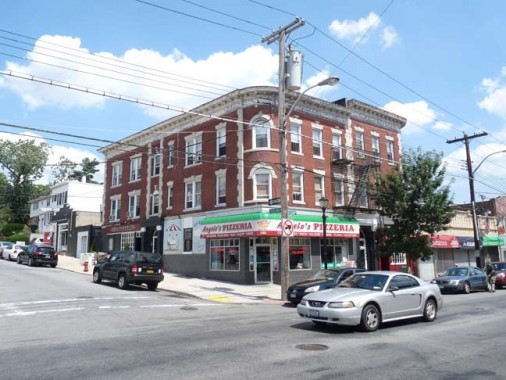

Southern Westchester County, while it gets quite rural the further north you go, is fairly indistinguishable from the northern Bronx here in Yonkers.

These buildings on 242nd Street off Martha Avenue are associated with St. Mark’s Lutheran Church, which is just a block to the west on Kimball Avenue.
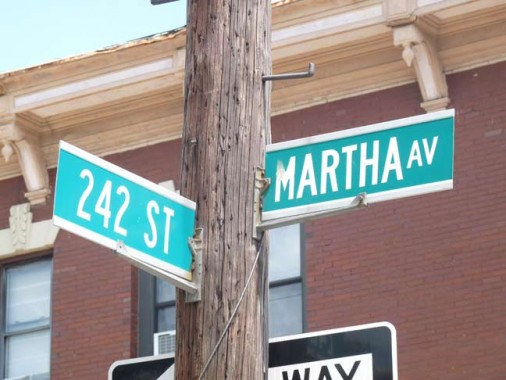
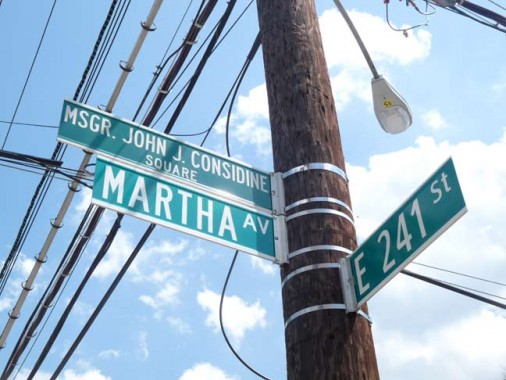
Once again, Westchester County and NYC green and white street signs are quite similar in appearance. But one more way you can tell them apart is the presence of an “E.” When a numbered street originating in the Bronx wanders into Yonkers, they drop the E for East, as Yonkers doesn’t make a distinction between east and west numbered streets.
“Barnabas” is a big name in the Bronx. There’s St. Barnabas Hospital on Third Avenue in the Belmont section, and here’s St. Barnabas Roman Catholic Church on Martha Avenue and East 241st.
The Parish was established in 1910 and placed under the patronage of St. Barnabas with the Reverend Michael Reilly as the first Pastor. The Parish included what is known as the Woodlawn section of the Bronx and McLean Heights/Yonkers entity, the Church and Rectory were erected on the actual line separating the two cities.
Under Monsignor Reilly’s leadership, a church of Roman architecture was completed by 1911. Before his death in 1947, he had built a Rectory and an Elementary School as well as a High School. He was truly a Founding Father. The Church in New York owes a debt of gratitude to his vision. St. Barnabas was to become one of the largest parishes in the Archdiocese. St. Barnabas
Msgr. John Considine served the parish between 1965 and 1986.

McKeon’s Pub, which takes pains to mention it’s “Irish and American” and illustrated the point with a pair of flags — as do nearly all the pubs on Katonah and McLean Avenues. Even though Woodlawn is in a different city than Yonkers, they may as well be the same neighborhood though they are totally different politically.


As I walked nearly the whole length of McLean Avenue this trip, I noticed a couple of vintage guy-wire stoplights. Like the neon and awning signs, they still get the job done, so why replace them? Sometime it seems NYC replaces its street fixtures for the sake of standardization, which seems to me to be a waste of money.


Gen. Joseph Stilwell Memorial Park, McLean and 240th Streets. The plaque, worn to almost the point of illegibility, was placed before the park was named for the general. It reads:
In commemoration of those who faithfully served their country in time of war. Dedicated by the presidents of McLean Heights and Wakefield Park, Yonkers, NY, May 30, 1932.
Bottom: To those who live beyond their hearts offer tribute as our memories of their sacrifices glow ever vivid with esteem and love. Humanity will remember the heroes who fought for liberty and justice.
Committee: Mothers Club, School No. 11
Avalanche Hose Co. No. 7
Wakefield Taxpayers Ass’n
Ben Arkinson Ass’n & Ladies’ Auxiliary
General Joseph Warren Stilwell (March 19, 1883 – October 12, 1946) was a United States Army four-star General known for service in the China-Burma-India Theater. His caustic personality was reflected in the nickname “Vinegar Joe”. Although distrustful of his allies Stilwell showed himself to be a capable and daring tactician in the field but a lack of resources meant he was forced continually to improvise. He famously differed as to strategy, ground troops versus air power, with his subordinate, Claire Chennault, who had the ear of Generalissimo Chiang Kai-shek. George Marshall acknowledged he had given Stilwell “one of the most difficult” assignments of any theater commander. wikipedia
As a youth, Gen. Stilwell resided in Yonkers and graduated from Yonkers High School.
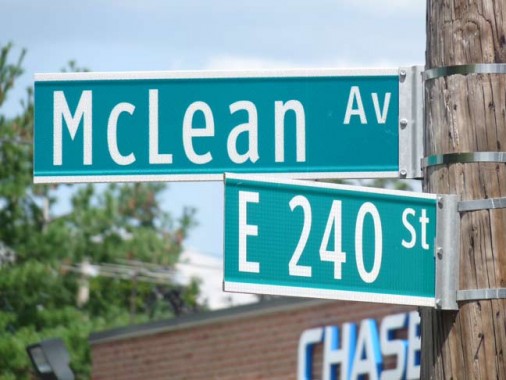
This is the one and only Bronx street sign that bears the name McLean Avenue. If you look at a map, between Vireo and Webster Avenues, the Yonkers-Bronx line appears to run down the center of McLean Avenue.
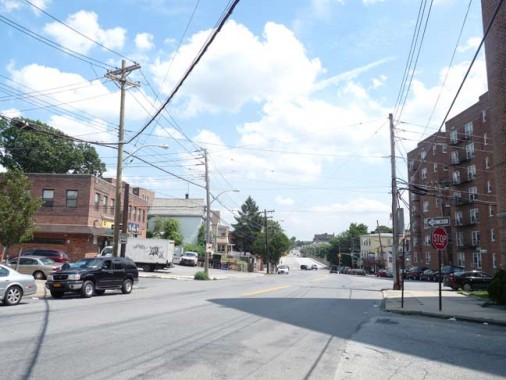
NYC, however, determines this piece of McLean Avenue to be a part of East 240th Street, so officially, McLean Avenue does not appear in NYC street directories. Seems rather petty to me to leave out McLean Avenue.

Crossroads. In the foreground is East 240th/McLean Avenue; directly ahead is Nereid Avenue; on the left is Bronx River Road; and on the right is Webster Avenue. One intersection, 5 street names! That’s Bronx and Westchester politics for you.
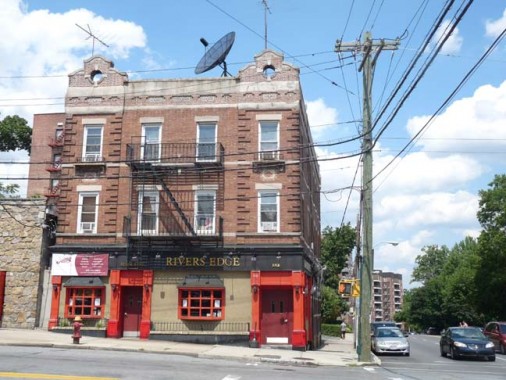
The Rivers Edge pub is a few feet away from the Bronx River which, believe it or not, is the only true river within the 5 boroughs. The Hutchinson River is considered a creek, and the Hudson is divided between NY and New Jersey. The East River is a strait between Upper New York Bay and Long Island Sound.
8/19/12

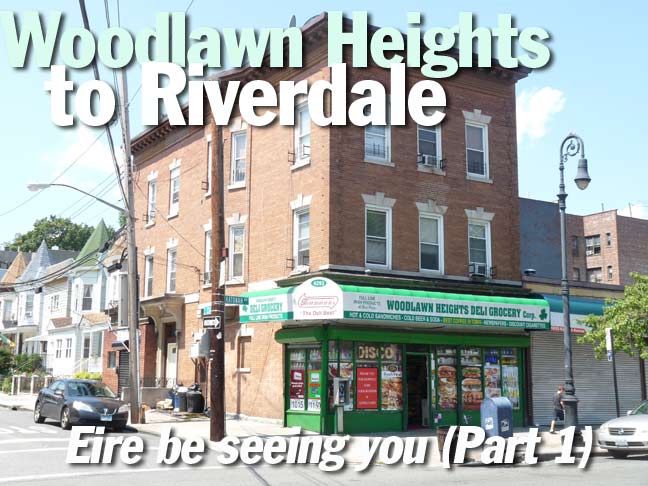
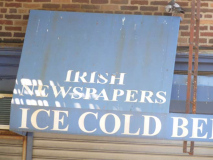
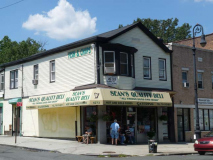
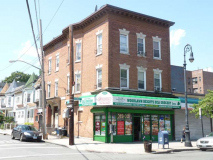
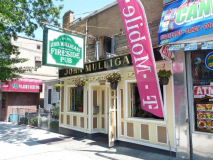
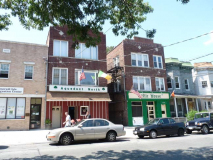
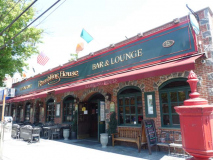
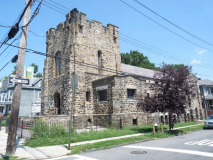
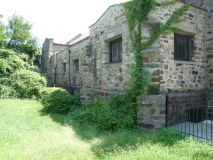
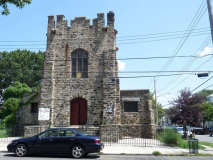
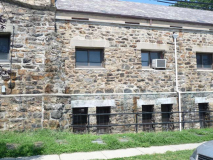
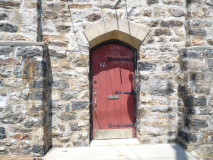
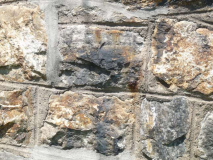
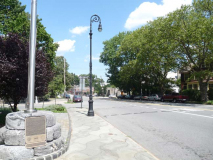
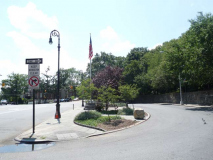
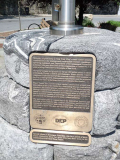
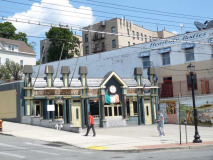
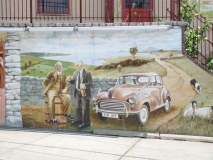
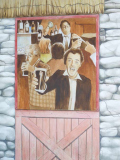
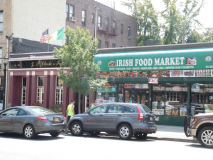
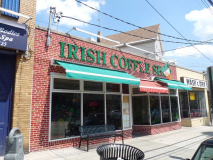


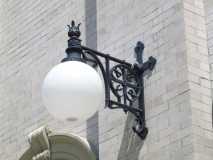
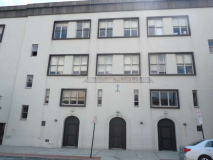
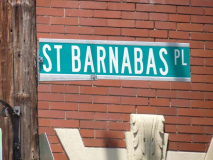
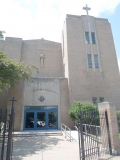
67 comments
Thank you,
These pictures brought back memories of my childhood growing up in this area.
What amazes me is that Woolawn, ” Heights” has not changed much, and remains much the same. I’m glad that the Irish are keeping the place the same. Even if some of the guys are nasty.
I suspect that is why it has not turned into an unlivable getto filled with crime and thugs, and unemployed bumbs, who pay no taxes.
I plan to send this site to my family and friends.
God Bless the Irish, their hard working families and their love of God, country and learning.
Someday they may even throw off the yoke of the tyranical unions. And realize they will be much richer. And have true freedom.
p
Thanks for these picture of Woodlawn Heights, because this is a neighborhood that isn’t shown most of the time, though a website known Bronx Pics is probably one of the few sites to show a good part of this neighborhood, while most don’t go past the cemetery.
Kevin, obviously people with cameras are suspicious people and need to be treated as such.
The Arcadia book “Northwest Bronx” identifies the church at Katonah and 241st as originally the Methodist Episcopal Church of Woodlawn Heights. The book has a photo of the congregation’s previous building and says they moved to a new one at that location in 1913. Later called St Luke’s United Methodist Church.
Woodlawn; Yeah I Love the Place !!!
Thanks for going up and checking out Yonkers! My family is from the Bronx originally but have lived in Yonkers for a few years now. There’s a lot of history in Yonkers but also a lot of new construction going on in the city.
A possible reason for the hostile reception you received from the guys at the drug store was that they or their parents are illegals. If they bother you again suggest to them that they should visit us here in AZ where SB 1070 has been upheld. It would change their lives, BO’s questionable executive order to the contrary.
No accents….
do you mean Irish brogues, not accents?
Same thing.
Thank you so much for the” look back”. I grew up in Woodlawn, went to school on Katonah (P.S.19), my husband grew up in McLean Heights, just off Mclean Ave. We used to go to the St Barnabus dances on Friday nights. Here we are in Florida married 61 years.
Thank you very much for the lovely stroll through Woodlawn. Except for interludes away at college and in the military, this was “home” from 1938 (age 4) until 1972 (a little older) — and it still is, despite 40 years of exile in the Midwest. I’m always delighted to see that not much ever changes in the old neighborhood. Some new pubs aside, some stores were there when I was a child. The Italian presence, still represented by the old pastry shop at the corner of McLean and Martha, used to be stronger: the River’s Edge Pub used to be Federico’s. Yet Merk’s Pharmacy has been Merk’s forever, which I always remember as a hospitable place. Thanks again, for a glimpse of one of NYC’s small near-Utopias.
A random memory tells me that the stone church at the NE corner of Katonah and E 241st was, in my childhood (1938-1951), a Methodist church. There was no Episcopalian parish in Woodlawn. The Presbyterian parish was located at Martha and E 240th (not shown). Your FNY page shows the RC and Lutheran parishes. And this building’s red door looks Methodist. But I’m 78 now, so I’m not about to swear to anything. Ancient memories tend to be vague….
Incidentially, I complained about FNY’s “thumbnail” photos when the Website changed formats a couple of years ago. The site has accomplished a huge improvement since then. All “thumbnails” are now very easy to view, enlarge, and manipulate. Many thanks!
The thumbs are larger now. I still have to go into the older pages w/ the small thumbs and fix them. The people who were transcribing the pages made a lot of errors. Unfortunately this will take a lot of time to do….
There actually was an Episcopalian Church, St. Stephen’s, on the corner of 238th st and Vireo Ave in the 60’s and 70’s. I lived on 238th, next ot PS 19 and then on Vireo until 1981, but I think the Church is another Religious demomination now, if it’s still there. Great Pictures!
Church is still there and still Episcopalian.
Dear John,
Are you the son or grandson of Cyril and Isabella Hayes?
Thanks in advance for replying if you are.
In reference to the one intersection with five street names,(Nereid Av, Bronx River Rd, McLean Av, 240th St, and Webster Av), the Nereid Av section is known to all the locals as the 238th St Bridge. Make that six names!
Exactly right! In ancient times, until just after WWII, swarms of black steam locomotives gathered just below the 238th Street Bridge. That’s where trains from upstate and New England swithed to or from electric power, to operate in the City. Swarms of boys gathered on the bridge to watch…. Thanks for the memory!
The name “238th St. Bridge” is identified by a metal plaque on the concrete wall of the bridge
(it can be seen near the center of the photograph, although obviously much too far to read).
Montefiore, or Monte North, is the third name of the hospital. It was originally named Misericordia. It went from part of the Catholic Health care system to being part of the United Jewish Appeal/Federation of Jewish Philanthropies. I think the very statue that used to be in front, is now at Our Lady of Grace on Bronxwood and 225th.
Great pictures..Thank You yet again…I remember the McLean Avenue trolley car that carried people down to the County line so they could get the IRT into town….also, the Yonkers Ferry across the Hudson, still in service into the late 40’s…..
According to the Google Map accompanying this FNY page, it looks like Part 2 will track part of the trolley’s route. Starting from the IRT’s Woodlawn Station (IRT # 4 Line), the old # 4 Trolley (part of the Yonkers division of TARS) ran northward along (cobblestoned) Jerome Avenue / Central Avenue to McLean, where it turned left / westbound on McLean as far as Broadway, in downtown Yonkers. The line terminated at Getty Square. I believe it continued in operation until November, 1952.
If I’m not mistaken, the Yonkers Ferry (from Yonkers Pier, still extant, to Alpine NJ) continued operating until 1957, or so.
Did they guys at the pharmacy have a dog laying on the sidewalk next to them?
There is two mta buses that I’m currently aware of that actually make stops outside the city, (three lines total that run out of the city) the BXM3 goes to Getty Square which I know is Yonkers, and the S89 goes to Bayonne, which is in Jersey, and then there’s the Q113 which doesn’t make any stops outside the city, but does go from Jamaica to Far Rockaway via Brookville and Rockaway Blvd, and entering Lawrence and Inwood, Long Island before going to Far Rockaway, and if you’re on Yonkers Avenue during the middle of the day, especially during the week, you see dozens of MTA express buses zooming up and down, so it’s not like we just see Beeline and Nice Buses coming into the city, it can be the other way around at times…..but not quite as much as the reversal…..
I hadn’t been there before and haven’t been back since, but in the early 90s my friends and I went barhopping on McLean Ave maybe a half dozen times, for some reason. We frequented 5 or 6 establishments centered around Central Park Avenue, and they all seemed fine. My superficial impression of the neighborhood was that it was decent and mostly American middle class. The one off-note struck came when we entered the Dew Drop Inn. Don’t know if it’s still there, but I think it was the first pub on the south side of McLean west of Central Park. It seemed like a rowdy but friendly blue collar place, until I spied some stone-faced youth grouped around the pool table in the side room, all dressed like the Ramones. But I could tell immediately they weren’t trying to dress like them, and that they weren’t in a band. My blood ran cold for a second, but after a shot or two and a move to a new location I soon forgot them. A few years later I read the classic novel The Wanderers, about 60s Bronx youth. When I got to the part about the Ducky Boys gang, the first thing that popped into my head was the memory of those kids in the Dew Drop Inn.
Too bad you had to encounter some hostile lowlives there. But you hardly need me to tell you, in the words of Lemmy from Motorhead, “don’t let ’em grind ya down!” Keep up the good work!
Dew Drop Inn is now Durty Nellys, which takes its name from a well known pub in Bunratty, County Clare.
When I was a small child in Woodlawn, the little War Memorial monument in (what was later to become) Stilwell Park, at thecorner of E 241st Street and McLean Avenue, was the focus of patriotic events for the neighborhood. That’s where a stand was erected for local dignitaries to review Memorial Day and Armistice Day parades. Before 1941, lots of Doughboys and even a few veterans of the Spanish and Philippine wars would march by. But I’ll never forget the occasion — I can’t remember the year, between 1938 and 1940 — when my Pop pointed out two old guys riding in the rear seats of open convertibles, wearing blue jackets and kepi caps. The Union still abided, in Woodlawn!
To update or correct an earlier remark of mine: I can’t recollect an Episcopalian parish in Woodlawn from my childhood years, but St. Stephen’s is there now. It’s located near the corner of E 238th Street and Vireo Avenue.
Woodlawn has always been a hospitable place. I trust some rude slackers lounging near Merk’s won’t damage FNY’s image of the neighborhood excessively.
A few notes:
Some Woodlawn males are complete jerks, and I think you ran into a group outside of Merks. I was wondering when you were going to see the signage, especially on the Hearing Aid Center.
I was born in Misericordia Hospital, which went on to be renamed Our Lady of Mercy Medical Center, and then was taken over by Montefiore as its North division.
Woodlawn has an Episcopal Parish, St. Stephen’s Church http://www.ststephenswoodlawn.org/index.html
You’ve got a knack for capturing great photos of New York life. I’ve sent lots of out-of-town friends to your blog to see what life here is like. Keep it up!
A trip down memory lane for me-anybody remember the best little toystore on Mclean Ave?name
and the stationery store Blackman’s? My grandparents were married in the small original St. Marks
Lutheran church and my parents in 1943 the “new” larger St Marks at Kimball Avenue, St. Marks for years always supported the Boy Scouts and the Girl Scouts.And, yes, pizza was the best at Federicos! Visitng a few years back ,the prinicipal of St Marks school gave me a tour of the church and also told me the church basement was filmed for the movie Doubt with Meryl Streep. And of course the Saturday matinees at the Kent movie theater kept us kids happy during the 1960’s!
I still can remember seeing ” The Tingler” with VIncent Price there and hearing the screams from the balcony!
I loved Woodlawn. I attended St Barnabas for 2nd, 3rd, 4th, and fifth grades. I loved the school and church. Visited Blackman’s for a lot for toys and things. I too remember the old Kent Theater on McLean Ave and Leon’s news and coffee shop near by. Yes, my parent bought Pizza at Federicos too. My brother and I won a lot of races at Van Cortland Park that were sponsored for the youth by the American Legion to my knowledge. I too remember the ole Rexall drug store across from St Barnabas. The owner was always nice and down the street was Levinson’s drug store on Mc Lean near Martha.
Diane , Blackmans and the kent Theatre was wonderful….The toy store are you referring to Kellys across from Stillwell park…It sold Aurora race sets and models…Federicos was owned by my families good friends ….I miss Home….in Florida Now….Peace…
About a decade ago, as part of an early series called “Borderland Crazy”, I think FNY previously visited Woodlawn, with a page named “Woodlawn & Wakefield”, or something like that. It started with some interesting pictures alonk Katonah and McLean Avenues, and then continued eastwardalong the truly weird boundary between The Bronx and Mount Vernon. For the life of me, I can’t find the page in FNY’s current index. But I’m a Neanderthal geezer.
Blackman’s Yes, indeed! The original store opened on the North side of McLean, some three or four storefronts West of Woodlawn Avenue (in Yonkers) when I was just starting at St. Barnabas Grammar School — maybe 1940, or so — but Joe Blackman soon acquired the property at the NW corner of McLean and Woodlawn, where his “Department Store” (as he came to call it) lived happily ever after. That’s where everyone in the neighborhood bought everything, even though it was just a single small storefront. Blackman’s was still going strong, when I had to move away, in 1972.
https://forgotten-ny.com/2003/07/borderline-crazy-part-ii-part-two-in-a-series-exploring-nycs-boundaries-with-other-municipalities-second-in-the-series-the-bronx-wakefield/
Thank you very much!
While I’m at it, “Cinema Treasures”, a great Website for fans of old movie houses, has a fine page about Woodlawn’s late and much lamented Kent Cinema. The “comments” are unusually elaborate for a minor neighborhood theater. Check the link at: http://cinematreasures.org/theaters/11837
In reference to the McClean Avenue “Artuso Pastry Shops” sign….there is another Artuso pastry shop in The Bronx, Arthur Avenue area. They are related. Great website…
Wow great photos.
Intersting.
Enjoyed your site immensely, for I always considered Woodlawn Heights as “My Hometown”.
Grew up there in the Depression Days, went to War after Pearl Harbor with all the Woodlawn boys.
Know every street, stores and places in those photos, and many others.. Those were the Days when the Area was predominately German- Irish families. Class of January 1936 PS19, Married at St Barnabas
Thanks for you Site
Wonderful pictures. I also grew up in Woodlawn at the same time as you did. In fact I recognize your name. Perhaps you went to school with my brother.
So enjoy your site and the photos and comments. Too bad some of the words were cut off.
I attended St Luke’s United Methodist Church @ 311 East 241st St, Woodlawn from 1943 to 1965. The church closed, due to low attendance, in the late 70’s and was vacant for some time, I recall. (currently Trinity Church but not sure of its denomination).
In 1975, St Luke’s United Methodist Church celebrated its 100th anniversary (1875-1975). A history of the church and Woodlawn was included in the program. Here is some of what was printed: ” In 1863, Woodlawn was made up of not more than a half dozen houses. Forty or fifty houses were erected within the next decade. The village grocery was that of Griswold & Garrett built in 1875 now occupied by a gas station at corner of 233rd St and Katonah Ave. A little group of Christian people felt the need for a place to worship and in January 1875 organized the Woodlawn Hgts Methodist Episcopal Church. They met in people’s homes until the spring when a huge tent was purchased and placed on 237th St, where a church & parsonage were later erected. E K Willard donated the property. Cornerstone laid in late Dec 1875 (assume it was at the 241st St location. A pioneer present on the occasion wrote “we had unusually warm weather, 75 degrees on Christmas and New Year’s Day. Plenty of mud, mud up to the hub, but it did not hinder the work pushing to completion”. He remembers his first year in Woodlawn-no street lights or streets, no city water, no school for the children, no church for the grownups, but just the best band of workers any community could boast of….
My memories of St Luke’s are wonderful. It was a beautiful, well cared for church and loved by its small congregation all those years as St Luke’s. A very sad day when it was forced to close its doors.
Glad to see that Woodlawn is flourishing and still continues to be a good place to live in NY.
I took a short walk on Katonah Ave yesterday and saw the church I commented on almost a year ago. But on to another item…
At the bus loop with the memorial to the sandhogs, did you not notice the rest of the memorial? Or was it not there yet? Next to the pile of New York rock, in the pedestrian path in the middle of the loop, is an array of manhole covers. Each one has cast into the metal the name of a tunnel worker who died on the job, with the year of his death. It’s weird and yet somehow so right. Among them is one “real” manhole cover, in line with some of the others, next to a drinking fountain. And what could be more appropriate than offering the visitor a way to taste that pure upstate water?
Just inside the nearest entrance to Van Cortlandt Park is a door and window of a building set very hobbit-like into the hillside. There is no Keep Out sign, or any other sign. There is around it an easily scaled fence and gate, and a uniformed guard inside a booth whom you cannot see behind mirror glass, until he comes out. Don’t make him come out.
Will have to check it out again…
Nursery Road. That is the entrance to the underground water tunnels accessible only by a deep elevator. It is amazing and of course has security present
By the way the water fountain isn’t working.
This is great! I moved here a few months ago and have been trying to learn more for a project I’m working on… (plus, it’s interesting!) I was confused about the “Trinity Community Church” as well. Neat reading all the comments, too.
As a kid, in the mid 70’s, I used to live there and attended St. Mark’s Lutheran School. I have nothing but fond memories of this place. We were Asian immigrants but the Irish folks treated us with utmost respect. Thanks for a walk down memory lane.
Thanks for the time and effort putting this together for all to enjoy. For info, Carmine’s Hearing Aid Service is from the early 1970’s. Before this it was a “coin shop” where you could exchange your 1964 or previous years silver change for a bit more than face value (1965 coins and onwards have copper also, which we use today).
Thanks again, very nice website indeed.
While Woodlawn is largely an Irish enclave and has been for some time, it wasn’t always. The Irish were always represented in Woodlawn. But, until the early to mid 1960’s Woodlawn was largely German. More Irish as well as some Italians and others migrated from the southern areas of the Bronx to Woodlawn during this time. It wasn’t until the early to mid 70’s that new Irish immigrants began to appear in Woodlawn as well as the Fordham and Kingsbridge areas
I am looking for info re a beauty parlor on McLean ave in the 1950’s. Owned by Arthur and his brother….don.t know surname.
My grandfather married their mom after they were both widowed. Her name was Rose and she married Peter VERLEZZA. We are trying to find Rose’s last name and her family. Unfortunately all our relatives who would remember have passed.
Any info you may have would be greatly appreciated.
What a lovely trip down memory lane….Woodlawn was home to me for over 10 years…I got married in St. Barnabas but was sadly widowed shortly after. The Irish community there was overwhelming wonderful to me. It had a lovely family feel and so safe. Have so many fond memories and made so many wonderful friends there. Still miss it so much.
I grew up on First St. and Sterling Ave. from the early 50’s to the mid 70’s. Carmines Hearing Aids was previously a pharmacy with a lunch counter. I attended St Barnabas Elementary from 1960 to 1963 and ate lunch on many occasions at the pharmacy. As I remember it, I would get tuna salad or egg salad sandwich and a soda / egg cream for $.050. It was a few years after that when it became Carmine’s.
Did you work at Cardinal Printing with someone named Dennis?
Thanks so much for your article on Woodlawn. I would like to correct one statement you make: “Woodlawn Heights has been Irish since the 1840s.” I am so-o tired of hearing how the Irish settled Woodlawn!!
In point of fact, Woodlawn was heavily German in its early years. I know because my family, the Roemers, settled there in 1865, establishing the first retail flower shop in the area (Peter Roemer, Florist) and building one of the first houses that was not a farmhouse in the area. The Irish began arriving in the 1860s when the railroad was built to transport caskets from Manhattan up to the newly-opened Woodlawn Cemetery, but they settled up near Van Cortlandt Park in what was then called “Irish Town.” The farmers already living in the area were of either Dutch or German extraction with names like Van Cortlandt, Opdyke, Willard, Tier, Bussing etc.
When I was growing up in Woodlawn in the 1950s, most of the shops along Katonah Avenue, from Mr. Schnell’s Tailor Shop to Mensing’s Delicatessen, Soehlke & Schmidt’s Delicatessen, Goeckler’s Bakery, etc. were owned and operated by German merchants. (The butcher replaced by Paul & Dom Iaria was a Mr. Steiner, also a German.) There were a few Italian-owned shops (Guido’s Beauty Parlor, for instance and Katonah Drug Store run by the Siragusa brothers). Candy stores on the northeast corner of 235th and the southeast corner of 237th were run respectively by Rudy & Shirley (last name unknown!) and Frank & Sylvia Shandler, while Mrs. Goldblatt ran a 5 & 10 cent store on the northwest corner of 236th. There were no Irish pubs, just a neighborhood bar or two. And — there was nary a shamrock nor an Irish flag in sight anywhere along the avenue!
The pictures are more of Wood-Lean than Woodlawn
I spent my very early years in south Yonkers in the late forties to the mid fifties. There was a German bakery on the south side of McLean, west of the theater, to my recollection. It had the most delicious breakfast cake that was dotted with butter and sugar. There were also two “stationary” stores with soda fountains that were at each end of the block (same side). The kids preferred the one closest to Kimball, and sodas were 5 cents. There was a vacant lot on the east side of Alexander and McLean that appears to be the site of an Irish Pub now (?). Next to this on McLean was a “bowling alley”, which to the kids meant a place where men would drink during the day, and the kids would quickly bypass it. Would love to hear if anyone knows more specifics about these sites, especially the German bakery.
I believe you’re thinking of Boehringers Bakery which was just off Martha Ave. at 179 Mclean Ave.
One of the “stationary” stores was the Kent Sweet Shop that served egg creams and cherry lime rickeys at the counter with the high stools that spun around. The bowling alley was McLean Bowl owned by Tony and Felicia Collinari (sp?) which had two floors for bowling and the best foosball table around.
This brings back wonderful memories of growing up on McLean Avenue.
One of the two “stationary” stores was the Kent Sweet Shop. It had high stools at the soda fountain and served the best egg creams and cherry lime rickeys. The McLean Bowl had two floors of bowling above the bar and the best foosball table. Thanks for the memories.
I attended St Barnabas elementary school during 1950’s. I bowled at the bowling alley described, I too had egg creams and lime rickeys at Leon’s Kent Variety store before or after a movie at the Kent.
Thanks for the memories. My family moved to E 238th Street in the early 50s and we all went to St Barnabas church and school. PS 19 had a summer day camp, and a trip to the bakery on Katonah was a big treat. It was a wonderful place to grow up. Drove past the old house a few years ago and loved seeing how well kept it is. Was sad to see Kent theater gone, spent many Saturdays there growing up. Glad to see Woodlawn Heights still going strong
Kevin, great stuff. I was raised in Woodlawn in the 50s and 60s, first on East 238th then East 242nd People across the street from us seemingly had the front of their houses in the Bronx but the rear was Yonkers (St Marks Place) One summer night, a BBQ exploded and a fire ensued. NYFD responded and said “It’s Yonkers, not ours” At the same time, Yonkers Fire 13 responded, saying “It’s Bronx, not ours.” Jointly, they DID extinguish the fire. Magically, a case of beer (at least one) appeared from the homeowner and a virtual block party started. God, life was so much better then…………
I lived at e.239th and katonah from about 1957 to 1961..I came from a very small north east ohio town to woodlawn….things I remember, Mario’s delicatessen, lillian’s 5and dime,burkes delicatessen, Mcleans(?) Bar, Henry’s soda shop( where the 15,16 year old girls used me to practice their kissing techniques while in the booths there…man I loved it!)…I remember looking up to the street toughs who looked out for the neighborhood and people there..so unlike today in so many places,PS 19,the 1 hour martinizin and the bakery next door….man that place,that neighborhood was the greatest…..have my best and most childhood memories right there from east240th and katonah to 233rd st…I to remember going to the Kent theater and seeing the Tingler…lol…..great stuff and great place to grow up…
Brings back memories.. I can almost taste that butter cake from Boehringer’s. We’d stop there after Mass at St. Barnabas ( very hungry since we fasted before communion in those days), and bring home that cake or some jelly donuts. I remember that hearing aid store as a beauty supply shop, and Finast supermarket before that. Artuso’s had italian ice in the front of their bakery that they hand scooped. Leon’s was next door, then I think there was a butcher shop, Nick’s deli, and a chinese laundry before you got to the Kent theater. I remember the other stationary store/ soda fountain at the other end of the street was Weller’s (now a Carvel I think). Across the street there was a bowling alley, but I remember the downstairs of it as Dillon’s bar. Also, near the Kent theater was Jean’s (?) 5 & 10, where I spent my allowance on coloring books, or small toys like a slinky or colorforms. I remember a very kind school crossing guard at the corner of McLean & Martha Ave., in front of Merk’s. I can’t recall her name (maybe Dottie?) but she always had a smile & kind word for me. Although a lot has
changed, I’m glad to see Woodlawn is still a great family neighborhood.